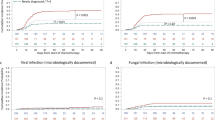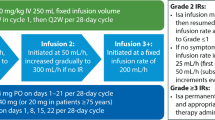Abstract
To determine whether the addition of lisofylline (LSF) to idarubicin (12 mg/m2 daily × 3) + ara-C (1.5 g/m2 daily × 4) affects the rates of infection, serious infection, CR or mortality during remission induction of newly diagnosed AML, RAEB-t or RAEB, we randomized 70 patients to 3 mg/kg lisofylline or placebo every 6 h i.v., to begin 6 h before the first dose of idarubicin and to continue until recovery of neutrophil and platelet counts or for 28 days, whichever came first. Eligibility required that patients be below age 71 years, have no history of abnormal counts, or chemotherapy for a prior malignancy, and have a creatinine <1.6 mg/dl and bilirubin <3.0 mg/dl. the study was double-blinded and infections were tabulated separately and independently at md anderson and by a three-member outside panel of experts. logistic regression was used to assess the relative effects of treatment arm (lsf or placebo), age, performance status, treatment site (laminar air flow room or not), and cytogenetics on rates of infection and serious infection following the first course of chemotherapy, and on cr rate. there were 84% and 87% concordance between the expert panel and md anderson enumerations of infection and serious infections, respectively. both analyses found no significant (P < 0.05) differences between the rates of infection, or serious infection, in the placebo and lsf groups. cr, 60-day, and overall mortality rates were similar in the two groups, as were time to neutrophil and blood count recovery and outcome once in cr. logistic regression analyses supported the above conclusions. severe nausea/vomiting and mucositis were more frequent in the lsf group. our results suggest that larger studies of lsf in newly diagnosed aml, raeb-t, or raeb are not warranted.
This is a preview of subscription content, access via your institution
Access options
Subscribe to this journal
Receive 12 print issues and online access
$259.00 per year
only $21.58 per issue
Buy this article
- Purchase on Springer Link
- Instant access to full article PDF
Prices may be subject to local taxes which are calculated during checkout
Similar content being viewed by others
Author information
Authors and Affiliations
Rights and permissions
About this article
Cite this article
Estey, E., Thall, P., Reed, P. et al. Treatment of newly diagnosed AML, RAEB-t or RAEB with lisofylline or placebo in addition to chemotherapy. Leukemia 13, 850–854 (1999). https://doi.org/10.1038/sj.leu.2401443
Received:
Accepted:
Published:
Issue Date:
DOI: https://doi.org/10.1038/sj.leu.2401443



